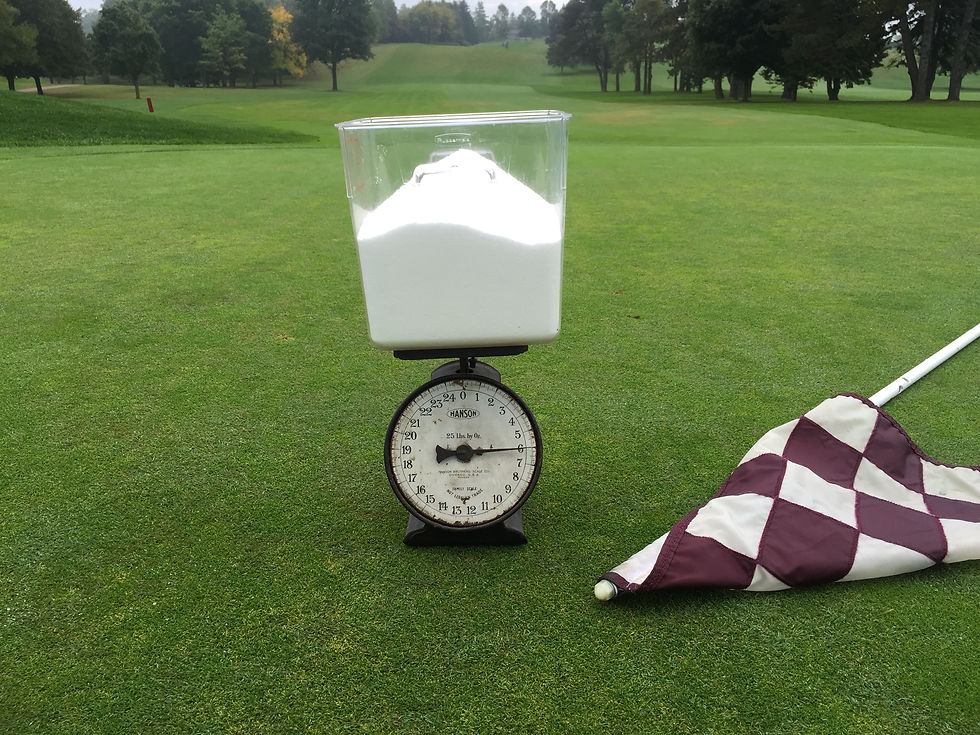Water & Water Quality
- bgreen61
- Sep 28, 2015
- 3 min read
Water management is a critical component in today’s golf course operations. Golf Course Superintendents are employing practical and scientific techniques to reduce overall water usage and utilize water more judiciously and efficiently.
Some of these methods include:
Efficient irrigation design- ability to water specific areas on the golf course with optimal distribution.
Computer software - provides the ability to run custom programs and adjust run times at each irrigation head individually.
Irrigation Auditing
Daily moisture content monitoring
Monitoring evapotranspiration rates
Remote access in the event of rain
Hand watering
Wetting Agents -used to assist in water retention and management in the soil
Turfgrass species and cultivar selection

This is a snap shot of 18 Green at Cutten Fields after loading data from the Pogo moisture meter. The Pogo also has the ability to measure and map soil temps, EC, and Salinity Index.
Here at Cutten Fields we are well situated to utilize all these techniques to manage our water usage to its maximum potential. In addition I find the membership to be very tolerant and even encouraging when it comes to having some dry brown spots in fairways and rough. Turf playability and health always come before color. If firm and fast is the desired conditions then brown dry turf will be present. This is a trend that will become more common on golf courses as more stringent water restrictions are put into place.
One of the biggest challenges facing Cutten Fields is not water delivery or quantity, but water quality. There are two sources of water we draw from to fill the irrigation pond; the Eramosa River and the creek that runs along 14 fairway, referred to by our consulting agronomist as the creek of death due to its extremely poor water quality. The river water is significantly better, but it too falls on the poor side of the water quality spectrum. Once the two sources mix together in the pond we fall somewhere between bad and really bad. As residential and industrial development continues to grow on the east side of Guelph, the river water will continue to decline in quality. Poor water quality in the Eramosa River is caused by the water run off from parking lots, driveways and roads that are treated with salt (sodium) to keep snow and ice off the roads.
There are numerous factors and chemical reactions that take place in the soil that influence water quality which makes it poor for turf health. In some way or another they all are directly or indirectly related to the presence of sodium. Sodium in irrigation water is absorbed by roots and foliage and foliar burning can occur if sufficient amounts accumulate in leaf tissue. Creeping Bentgrass and Poa Annua greens are particularly susceptible to sodium toxicity because they are mowed very short, irrigated frequently and subject to other stresses. In addition, excess sodium can result in destruction of soil structure and reduced water percolation through the soil profile.
While evaluating water quality data anything greater than 70 mg of sodium per litre of water is considered detrimental to both turf and soils. The most recent water test from the pond was 181 mg/L of sodium. Based on these numbers we can calculate that for every inch of irrigation water applied to the turf, we are also applying roughly 6 lbs of sodium per green.

Six Pounds of Sodium applied to each green in one inch of irrigation water.
There are golf courses that have much poorer water quality than Cutten Fields. In the South Western United States, many golf courses use reclaimed water and there is an excessive amount of sodium in reclaimed water. Of course there are methods that reduce the impact sodium can have on turf. The most effective way to remove salts from the soil is to flush it out using calcium and lots of water to push the sodium down through the profile. Sand based greens and/or drainage can make this process much more effective as the sodium is completely removed from the rootzone system and into the drainage system. Sodium is considered to be very mobile in the soil and with no drainage the sodium can actually come back into the profile even after a flushing event.
Water and water quality can be a complex issue in managing turf. It is difficult to comprehend how watering can actually be harmful to the turfgrass system. Fortunately we do have a few potential options to either improve the quality of water we use or improve our ability to manage it. Investigating these options is currently underway.


Comments